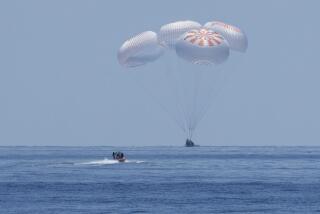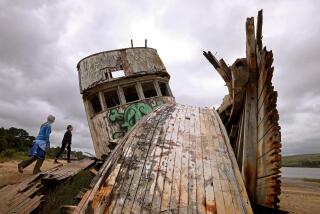Hull Trims Completed on Valdez; May Enter San Diego Bay Sunday
The Exxon Valdez probably will be maneuvered at sea today, then towed to the edge of state waters for final preparations before it is brought into San Diego Bay, probably Sunday morning, officials said Thursday.
Divers nearly finished trimming sagging steel from the ship’s damaged bottom Thursday, after cutting off more than 100 tons of such pieces that had peeled from the hull.
The U. S. Coast Guard and state Department of Fish and Game will observe the ship’s maneuvers, and the transit, estimated to take about a day, may serve as the mandated 24-hour period during which the tanker is prohibited from discharging any oily material before entering state waters, officials said.
Will Be ‘Reasonable’
Under an agreement reached Wednesday between the state and Exxon Shipping Co., that condition and others must be met before the ship will be allowed to enter San Diego Bay for repairs.
But the Coast Guard has said that, during the ship’s transit through federal waters, it can discharge material as long as the quantity can be contained by cleanup equipment surrounding the vessel, and state officials said they will be “reasonable” about their discharge stipulation.
“We will try to be reasonable in interpreting any clause, as we will hope Exxon will be. We’re not able to cookbook ( sic ) this situation,” said Reed Smith, pollution response coordinator for Fish and Game. “We’ll just have to be present and do the evaluation at the time, keeping in mind the environment, safety of the vessel, equipment and (the) agreement.
“A small discharge that is cleaned up immediately does not present a large threat,” Smith said. “I don’t know what more could be done at this point to ensure that there’s not a spill, unless they diaper the entire ship. But I can’t see now where any large amount of oil would come from.”
The vessel, still drifting about 5 miles off San Clemente Island, on Thursday emitted two small discharges of a bluish material as divers trimmed the hull, the Coast Guard said. Response teams were able to collect one sample before the material dissipated.
Sporadic Discharges
Such sporadic discharges have been observed coming from the ship’s hull since it arrived off San Diego on July 10, after being towed 2,200 miles from Alaska. The vessel, which hit a reef March 24 and dumped 11 million gallons of oil along pristine Alaskan shoreline, was scheduled to enter San Diego Bay on July 11 for a $25-million, nine-month repair job at National Steel & Shipbuilding Co., which built the Valdez in 1986.
But its entry was delayed by the discovery of an 18-mile-long oil slick believed to have come from the Valdez, as well as the massive steel plates jutting from its hull that had peeled away during transit.
After divers complete the trimming of the hull, the ship will be raised in the water a few feet and towed about 60 miles to the edge of state waters, where divers will stage a final underwater survey to check the hull for more sagging steel, said Coast Guard Lt. Larry Solberg. State waters extend 3 miles offshore, and federal waters generally extend another 9 miles beyond that.
Several small boats will form a moving safety zone 500 yards in front of and 300 yards to the side of and behind the Valdez as it enters state waters, in order to steer away small boat traffic, Solberg said. As many as 15 boats, including those carrying cleanup and response equipment, may accompany the vessel during its transit to a Nassco berth.
Also Thursday, results of state and federal tests on water from 15 of the ship’s 17 intact and damaged tanks showed barely detectable levels of oil. Two tanks were not tested.
‘The Ship Is Even Cleaner’
Tests by Exxon of 15 of the tanks showed that the water in all but two was nontoxic, the Coast Guard said, adding that the toxic water was not in danger of leaking because those tanks are sealed.
Tests of waxy oil residue on the lower depths of the ship’s damaged tanks are still being analyzed.
“The ship is even cleaner than when it was certified for passage to California,” Frank Iarossi, president of Exxon Shipping, said in a statement. “Most important, the EPA-approved toxicity tests have reaffirmed that the water in the damaged tanks is not toxic to marine life.”
But state officials said the water still poses a threat to marine life, which could be fouled, smothered or harmed by ingesting it, and they added that “free-floating oil” was found on the water surface in all of the tanks.
“There are other problems from oil than just acute toxicity,” said Smith of Fish and Game. “That test doesn’t help us very much, because there are many sublethal effects of oil that wouldn’t be tested by that.”
Mussels will be deployed as guinea pigs around the Nassco berth and in the bay to test the environmental impact of the Valdez, he said.
More to Read
Sign up for Essential California
The most important California stories and recommendations in your inbox every morning.
You may occasionally receive promotional content from the Los Angeles Times.









